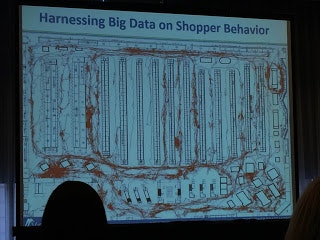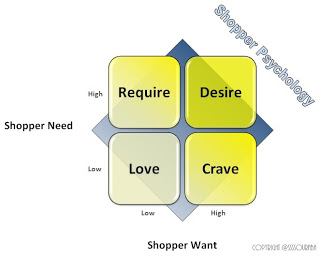Understanding Shopper Psychology

lines of eccentric, blurring the line between needs and wants.
Needs and wants are actually quite
distinct, contrary to thesauruses and non-lyrical businessfolks who
interchange them frequently. As I have blogged about at great length, these are not to be confused with the basic economics-related differences of needs and wants,
when placed in a shopping context, these meanings can deviate slightly.
Needs are essential, and at times necessary for a particular point in
time, whilst wants can be more compulsive, and when looked at from a
lateral perspective, unnecessary, but good to have. I am a shopper
motivated mainly by many, many wants! Which is why some may agree with
Cat Deeley in that 'I don't shop because I need something, I just shop for shopping's sake.'
Bearing in mind the needs and wants of shoppers, retailers spend
time, efforts, capital and much more to lure during the busy season.
Sales, discounts, bulk buys, freebies, multi-buy bargains, coupons,
gifts-with-purchase, and much more are common tactics utilized that have
been successful over decades. But how do these virtually compulsive
buying strategies compare to shoppers needs and wants?
Bearing in mind the needs and wants and their varying levels of
strengths, four emotive forms of enticement can be formulated, each of
which attract shoppers to the act of shopping. These allow shoppers to
grasp their shopping motivations better (if they have the ability or the
time to grasp their emotions in a flurry of dancing options). The four emotion-based quadrants of shopper psychology are as
follows.
Require: Products with a high need but a low want are generally ones that must be bought, hence required,
usually for utility purposes, technical support, or anything that is
necessary to sustain something else. Batteries, restroom essentials, a
lightbulb, or other elements that support the function of an entire
ambiance or event fall into this emotion. Some grumble over the added
cost this adds to an otherwise emotionally gratifying shopping trip,
often forgetting that these things are required for a reason.
Crave: With a high want but a low need, this feeling is best called crave. It depicts the urge to pick something up, knowing subconsciously that it may not be utilized frequently, will be a fad that loses steam quickly, and a perfect fit for the frivolous folks in the addiction framework.
Strange but attractive items like impractical but fashionable
accessory, holiday scented stuffed toys, or an nth belt, are all
examples of things that, as mom might say, we really do not need! Notice
how some of these end up taking volumes of space in closets, under
beds, in bulging drawers, or in misty attics.
Love:
For something with a low need and a low want, one may wonder why it is
bought after all! This is where impulse buying is most prominent. Ever
bought something because it was obscenely cheap (recall the 80% off
price!)? Ever bought something because it came with a freebie? Or bought
a cheap cosmetic product at a department store because of the herd of
products that come free with it? These are examples of a love driven
purchase.
Ever gazed at a magazine at checkout, or the packet of gum
staring at you with minty eyes and claims, or the sale priced food item
placed at the end of a cave-like aisle, which you find you have
purchased in no time at all?
These are all things you may not need nor
want. Besides thoughtless purchases, the mass market variety of severely
in vogue trends can fall here. Think of things you love to do because
everyone else does them: sport Ed Hardy paraphernalia, buy the Avatar
blu-ray, or pull out the Uggs in winter. Sounds like the societal pressure that retains a trend in the market, doesn't it?
Desire: And finally, there is the golden product: the one you desire.
You definitely want it, and you most certainly need it. Which is why,
as the laws of economics go, it is either usually scarce or pricey. A
princess cut diamond ring, an authentic artifact or accessory (versus
the knockoffs), or the exorbitant initial prices of the Apple family
products when they are released, and subsequently purchased in record breaking numbers.
Electronics fall into this category; and while some may argue we do not
fundamentally need or want them (thus quoting them as a love and not a
desire), since our needs are basic combinations of
food+shelter+clothing, statistics and behavior patterns show that most
houses do not sustain themselves without electronics or basic gadgets: computers, laptops, televisions and cellphones. Talk about an electrically warped world.
Next, we will see how retailers and "producers" of consumer goods can cater to these four segments, completing the picture on the rapidly evolving customer-retailer relationship.
Communication & Social Media Research Expert at SKIM, an international
consultancy and marketing research agency, has a background in engineering,
marketing and finance from the University of Pennsylvania, and the Wharton
School and Rotterdam School of Management. Having worked in marketing and
product development at L'Oreal, followed by a stint in management consulting,
he now passionately enjoys the world of social media, and can be found on every
platform with his alias sssourabh. He is a food critic and a fashion writer,
and documents these alongside strategy on his blog called 3FS. He may be reached at s.sharma@skimgroup.com.
Follow him on @sssourabh.
